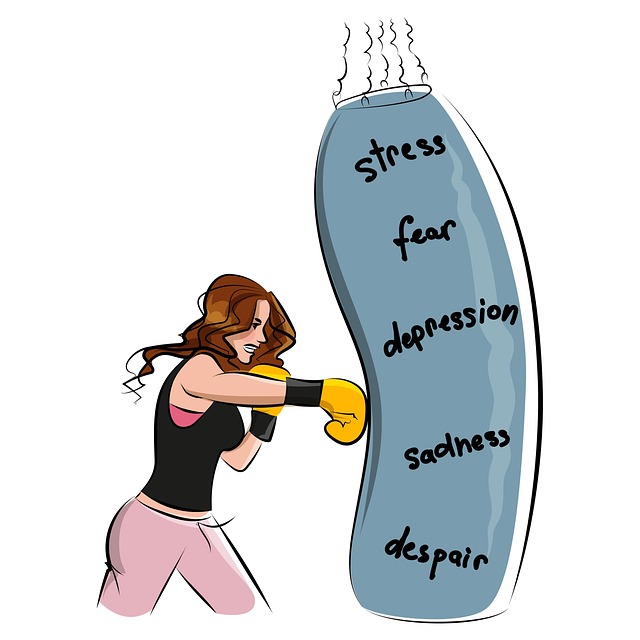Boulder Anxiety Therapy employs robust risk assessment and harm minimization strategies, led by Mental Wellness Podcast Series and guided by Mind Over Matter principles, to ensure client safety and well-being. They tailor interventions based on individual client histories, current presentations, and therapeutic goals, integrating compassion cultivation and evidence-based stress reduction techniques. Their structured risk management planning, proactive high-risk client identification, and regular revisions guarantee effective, personalized mental health care that addresses diverse patient backgrounds and leads to positive outcomes.
In the realm of therapy, risk assessment and harm minimization are pivotal for safe and effective practice. This comprehensive guide explores these essential aspects, focusing on Boulder Anxiety Therapy as a case study. We delve into understanding risk assessment, identifying potential hazards and benefits in therapy, and the crucial role of harm minimization strategies. Additionally, we provide a step-by-step approach to implementing risk management plans and present inspiring case studies from Boulder Anxiety Therapy, highlighting successful risk assessment and harm minimization practices.
- Understanding Risk Assessment in Therapy: Identifying Potential Hazards and Benefits
- The Role of Harm Minimization: Strategies for Safe and Effective Practice
- Implementing Risk Management Plans: A Step-by-Step Approach for Therapists
- Case Studies: Success Stories of Risk Assessment and Harm Minimization in Boulder Anxiety Therapy
Understanding Risk Assessment in Therapy: Identifying Potential Hazards and Benefits

Understanding risk assessment in therapy is a cornerstone of effective mental health practice. It involves systematically identifying and evaluating potential hazards and benefits associated with various therapeutic interventions, such as those offered by Boulder Anxiety Therapy. Mental health professionals must consider not only the immediate risks but also the long-term implications of treatment plans. By conducting thorough risk assessments, practitioners can tailor their approach to meet each client’s unique needs while ensuring their safety and well-being.
This process involves closely examining the client’s history, current presentation, and anticipated therapeutic goals. For instance, a Stress Management Workshop organized by a mental health awareness initiative may reveal potential risks like triggering traumatic memories or overwhelming emotions for some participants. However, with proper planning and mitigation strategies, these risks can be managed effectively. Mental health professionals play a vital role in navigating these challenges, ensuring that the benefits of therapy outweigh any associated hazards.
The Role of Harm Minimization: Strategies for Safe and Effective Practice

Harm minimization plays a pivotal role in risk assessment and is an essential strategy for mental health professionals, especially in settings like Boulder Anxiety Therapy. It focuses on reducing potential harm while ensuring client safety and well-being. This approach involves a multi-faceted approach, including comprehensive risk assessments, proactive planning, and implementing evidence-based interventions. By integrating compassion cultivation practices into their work, therapists can foster an environment of care and understanding, which is crucial for managing client anxiety and promoting mental wellness.
Effective harm minimization strategies require a structured plan that includes identifying high-risk clients, anticipating potential triggers, and developing safety protocols. The Mental Wellness Podcast Series Production highlights the importance of regular risk management planning for professionals to stay prepared. Through this process, therapists can effectively navigate complex situations, offer timely interventions, and ensure the best possible outcomes for their clients.
Implementing Risk Management Plans: A Step-by-Step Approach for Therapists

Implementing Risk Management Plans is a critical aspect of effective Boulder Anxiety Therapy. It involves a structured approach to identify potential risks and develop strategies to minimize harm. Therapists should begin by thoroughly evaluating each client’s unique circumstances, including their history, current stressors, and vulnerabilities. This process allows for the creation of tailored plans that address specific concerns.
A step-by-step implementation strategy includes establishing clear communication with clients about risk factors, regularly reviewing and updating plans as needed, integrating evidence-based stress reduction methods and empathy building strategies, and utilizing effective communication strategies to ensure client safety and well-being throughout the therapeutic journey.
Case Studies: Success Stories of Risk Assessment and Harm Minimization in Boulder Anxiety Therapy

Boulder Anxiety Therapy has successfully implemented risk assessment and harm minimization strategies, resulting in notable improvements in patient outcomes. These approaches, deeply rooted in Mind Over Matter principles, prioritize understanding and addressing individual fears and anxieties through tailored interventions. The therapy team leverages Empathy Building Strategies to foster strong therapeutic alliances, ensuring patients feel heard and supported throughout the process.
Through comprehensive Healthcare Provider Cultural Competency Training, therapists at Boulder Anxiety Therapy are equipped to navigate diverse patient backgrounds and beliefs. This training enables them to deliver culturally sensitive care, enhancing the effectiveness of risk assessment and harm minimization planning. By combining these strategies, Boulder Anxiety Therapy has achieved success stories that serve as a testament to the power of personalized, empathetic, and culturally competent mental health care.
Risk assessment and harm minimization planning are essential components of safe and effective therapy, particularly within the context of Boulder Anxiety Therapy. By understanding potential hazards and benefits, therapists can implement robust risk management strategies that ensure client safety while fostering positive outcomes. The step-by-step approach outlined in this article provides a practical framework for navigating these processes, as illustrated by successful case studies. Through diligent risk assessment and thoughtful harm minimization, therapists can revolutionize their practice, providing Boulder Anxiety Therapy that is both comprehensive and secure.








